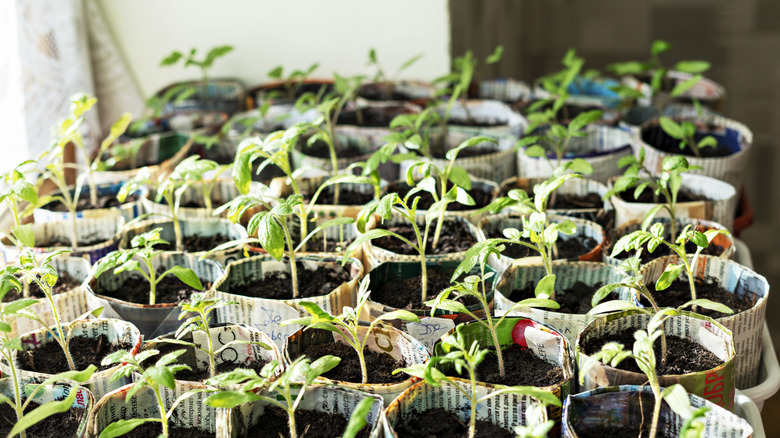Should You Use Newspaper To Line Your Planter's Drainage Holes?
Container gardening is the perfect solution for those living in condos or townhouses with only a balcony or patio to garden on. Renters, too, benefit from the moveability of this gardening method. One of the container gardener's chief complaints is potting soil leaking out of the pots they grow in. Unlike growers with large yards, you can't make your own dirt so quality potting mix is a core line item in your gardening budget. Plus, leaky pots are messy. What you're looking for are drainage materials to relieve your plants of excess moisture while keeping the soil inside the pot where it belongs. That material, many plant experts assert, is newspaper. Or is it?
The idea goes that you line the bottom of your pot with a few sheets of newspaper, fill it with soil, and plant as usual. Newspaper is absorbent, so while it creates a barrier against the larger particles of dirt, water can still flow through, ensuring the soil doesn't get too soggy. It's also biodegradable. By the time the plant has established its root system, the newspaper will be no more — and, coincidently, no longer needed to keep the dirt in place. The roots do that task quite nicely, thank you. There are, however, downsides worth exploring, from the newspaper retaining too much water to the liner being unnecessary in the first place.
Soiled reputation
You're giving yourself extra work by lining planters with drainage holes under half an inch wide with newspaper as there is not enough of a significant loss of potting mix to warrant taking this extra step, advises Dr. Joe Willis, horticulture extension agent at the Louisiana State University Agriculture Center, via Family Handyman. Houseplant expert Vladan Nikolic, speaking with Better Homes & Gardens, echoes Willis' statements: "If you use a porous and well-draining potting mix, enhanced with large-particle amendments, there's no need to put anything at the bottom of the container." It's also possible that, as the newspaper breaks down, it creates the perfect environment for mold, fungus, and other moisture-living diseases to thrive. And that's not great for your plant's roots.
Unexpected benefits to using a newspaper drainage hole liner outside soil retention plant a punch, though. If you have metal containers or are growing atop concrete or pavers, a layer of newspaper insulates the dirt and roots against damaging radiant heat, something that's especially a problem on sunny summer porches. Terra cotta pots might look good and help you say goodbye to plant pests, but being porous, they're notorious for drying out fast. A layer of newspaper in the bottom keeps them sufficiently damp. Newspaper is a carbon source, and carbon is one of the core components of healthy soil. All those printed words add nutrients to your pot as the sheets decompose.
Try it out
Overall, however, it seems the benefits outweigh the downsides. And, like most things in gardening, the idea may work for some patches, locations, and climates but not others. If you want to give it a go, keep a few best practices in mind. Add only a thin layer of newspaper. Hefty layers of a different medium to the potting mix in your pot raise the water table, creating a layer of moisture-logged soil. The result? Root rot. Consider using this idea only for plants you re-pot often. The Pottery Patch, an importer of quality ceramic planters to the U.S., recommends using newspaper only if you need a liner for a short time since, like other organic materials, it breaks down quickly, reducing its efficacy.
Cut a circle (or square or whatever shape you need) of newspaper — about three sheets thick — to fit the bottom of your pot exactly, or simply push a few full sheets down into the planter until it hits the base. If you're worried about the paper rotting, you can also cut out tiny squares just big enough to fit over the drainage holes. Wet the planter to help the pieces stay in place until you cover them with dirt. Don't have any newspaper on hand? Alternatives to try include coffee filters — they're designed to drain, after all; thin landscaping or cotton cloth (like old t-shirts, tights, or socks); torn window and door screens; net curtains; and even screen door repair tape.


